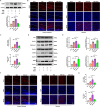The Neuroprotective Mechanisms of PPAR-γ: Inhibition of Microglia-Mediated Neuroinflammation and Oxidative Stress in a Neonatal Mouse Model of Hypoxic-Ischemic White Matter Injury
- PMID: 39496476
- PMCID: PMC11534457
- DOI: 10.1111/cns.70081
The Neuroprotective Mechanisms of PPAR-γ: Inhibition of Microglia-Mediated Neuroinflammation and Oxidative Stress in a Neonatal Mouse Model of Hypoxic-Ischemic White Matter Injury
Abstract
Background: Neuroinflammation and oxidative stress, mediated by microglial activation, hinder the development of oligodendrocytes (OLs) and delay myelination in preterm infants, leading to white matter injury (WMI) and long-term neurodevelopmental sequelae. Peroxisome proliferator-activated receptor gamma (PPAR-γ) has been reported to inhibit inflammation and oxidative stress via modulating microglial polarization in various central nervous system diseases. However, the relationship between PPAR-γ and microglial polarization in neonatal WMI is not well understood. Therefore, this study aimed to elucidate the role and mechanisms of PPAR-γ in preterm infants affected by WMI.
Methods: In this study, an in vivo hypoxia-ischemia (HI) induced brain WMI neonatal mouse model was established. The mice were administered intraperitoneally with either RSGI or GW9662 to activate or inhibit PPAR-γ, respectively. Additionally, an in vitro oxygen-glucose deprivation (OGD) cell model was established and pretreated with pcDNA 3.1-PPAR-γ or si-PPAR-γ to overexpress or silence PPAR-γ, respectively. The neuroprotective effects of PPAR-γ were investigated in vivo. Firstly, open field test, novel object recognization test, and beam-walking test were employed to assess the effects of PPAR-γ on neurobehavioral recovery. Furthermore, assessment of OLs loss and OL-maturation disorder, the number of myelinated axons, myelin thickness, synaptic deficit, activation of microglia and astrocyte, and blood-brain barrier (BBB) were used to evaluate the effects of PPAR-γ on pathological repair. The mechanisms of PPAR-γ were explored both in vivo and in vitro. Assessment of microglia polarization, inflammatory mediators, reactive oxygen species (ROS), MDA, and antioxidant enzymes was used to evaluate the anti-inflammatory and antioxidative effects of PPAR-γ activation. An assessment of HMGB1/NF-κB and NRF2/KEAP1 signaling pathway was conducted to clarify the mechanisms by which PPAR-γ influences HI-induced WMI in neonatal mice.
Results: Activation of PPAR-γ using RSGI significantly mitigated BBB disruption, promoted M2 polarization of microglia, inhibited activation of microglia and astrocytes, promoted OLs development, and enhanced myelination in HI-induced WMI. Conversely, inhibition of PPAR-γ using GW9662 further exacerbated the pathologic hallmark of WMI. Neurobehavioral tests revealed that neurological deficits were ameliorated by RSGI, while further aggravated by GW91662. In addition, activation of PPAR-γ significantly alleviated neuroinflammation and oxidative stress by suppressing HMGB1/NF-κB signaling pathway and activating NRF2 signaling pathway both in vivo and in vitro. Conversely, inhibition of PPAR-γ further exacerbated HI or OGD-induced neuroinflammation, oxidative stress via modulation of the same signaling pathway.
Conclusions: Our findings suggest that PPAR-γ regulates microglial activation/polarization as well as subsequent neuroinflammation/oxidative stress via the HMGB1/NF-κB and NRF2/KEAP1 signaling pathway, thereby contributing to neuroprotection and amelioration of HI-induced WMI in neonatal mice.
Keywords: PPAR‐γ; microglia; neuroinflammation; oxidative stress; white matter injury.
© 2024 The Author(s). CNS Neuroscience & Therapeutics published by John Wiley & Sons Ltd.
Conflict of interest statement
The authors declare no conflicts of interest.
Figures











Similar articles
-
FGF21 Alleviates Hypoxic-Ischemic White Matter Injury in Neonatal Mice by Mediating Inflammation and Oxidative Stress Through PPAR-γ Signaling Pathway.Mol Neurobiol. 2025 Apr;62(4):4743-4768. doi: 10.1007/s12035-024-04549-y. Epub 2024 Nov 1. Mol Neurobiol. 2025. PMID: 39485628
-
Deacetylase SIRT2 Inhibition Promotes Microglial M2 Polarization Through Axl/PI3K/AKT to Alleviate White Matter Injury After Subarachnoid Hemorrhage.Transl Stroke Res. 2025 Aug;16(4):1075-1093. doi: 10.1007/s12975-024-01282-5. Epub 2024 Aug 5. Transl Stroke Res. 2025. PMID: 39103659
-
Inosine Treatment Attenuates White Matter Injury in Neonatal Rats Exposed to Maternal Inflammation.Neurochem Res. 2025 May 30;50(3):176. doi: 10.1007/s11064-025-04429-4. Neurochem Res. 2025. PMID: 40445478
-
A systematic review of p53 regulation of oxidative stress in skeletal muscle.Redox Rep. 2018 Dec;23(1):100-117. doi: 10.1080/13510002.2017.1416773. Epub 2018 Jan 3. Redox Rep. 2018. PMID: 29298131 Free PMC article.
-
Function and Mechanism of Abscisic Acid on Microglia-Induced Neuroinflammation in Parkinson's Disease.Int J Mol Sci. 2024 Apr 30;25(9):4920. doi: 10.3390/ijms25094920. Int J Mol Sci. 2024. PMID: 38732130 Free PMC article. Review.
Cited by
-
Targeting Neuroinflammation in Preterm White Matter Injury: Therapeutic Potential of Mesenchymal Stem Cell-Derived Exosomes.Cell Mol Neurobiol. 2025 Mar 12;45(1):23. doi: 10.1007/s10571-025-01540-6. Cell Mol Neurobiol. 2025. PMID: 40072734 Free PMC article. Review.
-
Traumatic brain injury: Bridging pathophysiological insights and precision treatment strategies.Neural Regen Res. 2026 Mar 1;21(3):887-907. doi: 10.4103/NRR.NRR-D-24-01398. Epub 2025 Mar 25. Neural Regen Res. 2026. PMID: 40145994 Free PMC article.
-
Pharmacokinetics and tissue distribution analysis of ginsenoside Rh3 in rats using a novel LC-MS/MS quantification strategy.Front Pharmacol. 2025 Jul 10;16:1582644. doi: 10.3389/fphar.2025.1582644. eCollection 2025. Front Pharmacol. 2025. PMID: 40709094 Free PMC article.
-
Targeting microglia polarization with Chinese herb-derived natural compounds for neuroprotection in ischemic stroke.Front Cell Dev Biol. 2025 Jun 10;13:1580479. doi: 10.3389/fcell.2025.1580479. eCollection 2025. Front Cell Dev Biol. 2025. PMID: 40556734 Free PMC article. Review.
-
Role of astrocytes in the pathogenesis of perinatal brain injury.Mol Med. 2025 Aug 13;31(1):277. doi: 10.1186/s10020-025-01328-w. Mol Med. 2025. PMID: 40804657 Free PMC article. Review.
References
-
- Benavente‐Fernandez I., Siddiqi A., and Miller S. P., “Socioeconomic Status and Brain Injury in Children Born Preterm: Modifying Neurodevelopmental Outcome,” Pediatric Research 87, no. 2 (2020): 391–398. - PubMed
-
- Raju T. N. K., Buist A. S., Blaisdell C. J., Moxey‐Mims M., and Saigal S., “Adults Born Preterm: A Review of General Health and System‐Specific Outcomes,” Acta Paediatrica 106, no. 9 (2017): 1409–1437. - PubMed
Publication types
MeSH terms
Substances
Grants and funding
LinkOut - more resources
Full Text Sources

